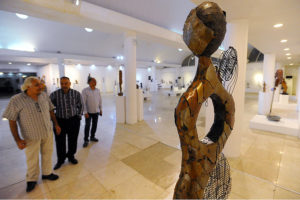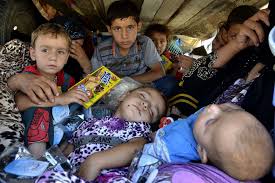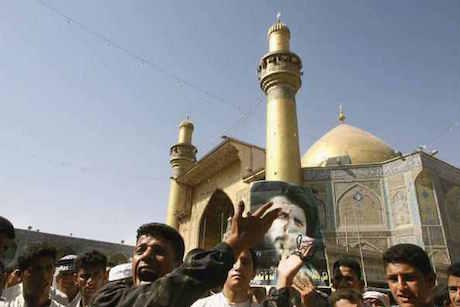
With the trials and horrors of sanctions and war retreating into the past, Iraqi artists are looking for their muse and markets as they seek to rebuild a creative culture.
NOVEMBER 28, 2017 BAGHDAD—The young Iraqi painter can’t help herself: She loves Iraq, she loves Baghdad, and she is determined to illuminate minds with her art despite monumental challenges.
The art market has shriveled in Iraq since the fall of Saddam Hussein in 2003. But Zahraa al-Baghdadi says she won’t let Iraq’s chronic violence force her to join the legions of Iraqis who have fled to Europe or the US.
“We all have a confused vision for the future, because of the things we saw here like war, like killing, like kidnapping,” says Mrs. Baghdadi, sipping tea in the Hawar Gallery, one of the last bastions of art still open in the Iraqi capital. “But still we love it. I can’t leave.”
That is the mantra of Iraqi artists determined to resuscitate a once-renowned past of Iraqi art, and to finally overcome the crisis of motivation that has afflicted Iraqi culture since the US invasion of 2003 and, to a lesser degree, before.
Baghdadi, who drew her first portrait at the age of six, of her teacher, says her work focuses on “human problems inside.” Her paintings can be large – 5 feet high – or tiny, at barely 4 inches square. But just like the disrupted canvas of her native Iraq, crippled by decades of war, her paintings are never child’s play.
Think you know the Greater Middle East? Take our geography quiz.
“I don’t want to show the simple, I just want complicated things to show,” says Baghdadi, who works from a home studio and cares for a 20-month-old toddler. “You have to stand for a long time in front of my paintings.”
Baghdadi, who wears the headscarf of an observant Muslim woman, is one of a small cadre of often secular Iraqi artists intent on finding inspiration in a homeland torn apart by decades of sanctions and war. Today they confront a creeping social conservatism and religiosity that seems to many practicing artists like just one more reason to feel restricted.
“We are a forgotten tribe, sir,” says Qasim Sabti, head of the Iraqi Plastic Artists Society, a renowned painter who has been a pillar of Iraq’s art scene for decades. He has run the society since the Saddam era, when the gallery building and its bar – built on land given by King Faisal in 1956 – was a hangout for Baath Party officials.
A critical challenge came in 2003, when criminals took over the building, stole the air conditioners, broke all the windows, and damaged much of the art. Mr. Sabti and a dozen other art society members arrived with knives and clubs to kick them out, and carried key archives to a nearby American military post for safekeeping.
Sabti had to start rebuilding the art community again from zero. But the violent sectarian civil war and insurgency shriveled the art market. The wealthy and middle-class Iraqis who once bought art moved away; Western diplomats who also bought local works disappeared behind the walls of the Green Zone; and nearly all of the Saddam-era galleries closed their doors for good.
Bursting with talent
Nevertheless, Iraq’s artists are stubbornly productive, and submissions for gallery shows and personal requests for support pile up. The challenge for years has been a test of resilience and survival, but with the crushing of the so-called Islamic State (ISIS) here, Iraqis – and the artists among them – are aiming to finally experience a degree of normalcy.
Iraqi artists mourned in 2003 when the National Museum in Baghdad was largely looted, with priceless ancient artifacts finding their way onto the global market. And they mourned again as ISIS destroyed – one bomb and one sledgehammer blow at a time – ancient works and shrines they found in areas under their control.
Sabti still mounts 10 exhibitions a year for the society, including a stunning if varied array of sculptures now on show – from large bronzes to delicate carved wood – with partial funding from Western embassies. One traveling exhibit of Iraqi artists was scheduled to last two weeks at the Metz Museum in France, but was so popular it stayed up for four months.
“There is more and more interest in art; we need only safety,” says Sabti, letting out a sigh as he strolls around the renovated gallery space, with its white-washed modernist interior lines and sculptures set on white plinths. “This jack-in-the-box will burst open, because we have talented people.”
Need for support
But the obstacles to reviving the art market in Iraq are immense, even though the Plastic Arts Society and the Academy of Fine Arts, founded in 1968, boast thousands of members and students nationwide.
“What annoys us and makes us tired, is there is a big distance between us and the government and [Shiite] religious groups, which lead people to the caves and to darkness,” says Sabti. Government support is negligible for art, he says, though it finds millions to support “foolish [Shiite] religious ceremonies.”
Proceeds from the long-popular bar enable the society to help the families of poor artists, even with medical bills, and provide gifts of oil paints, canvas, and brushes “to encourage young people to continue,” he says.
Sabti’s own sculptures have generated enough sales during exhibits in New York, Tokyo, Hiroshima, and elsewhere so that he also helps young artists stay in the business. He owns the Hawar Art Gallery, which he has kept open since the 1990s, where he still showcases new talent.
“I am so happy to find those who need help,” says Sabti, whose shock of white hair is combed back, in an avant-garde style. “I teach high art, and feel an ethical responsibility to the next generation.”
Among them is Sabti’s own son Ahmed, a 28-year-old surreal artist and graphic designer.
“Before the war we had foreigners interested in art because they saw something different, and it was so cheap,” says Ahmed, sipping tea in the garden at Hawar Gallery. “After the war artists were not targeted, but artists had a problem to be inspired.”
To stay, or to go
At first, Ahmed wanted to move to the US, and traveled to Jordan to put in his paperwork. But he got depressed there, unable to focus on art outside of Iraq, and heard stories of how many years the process of approval to move to the US could take and how hard it was to make ends meet.
“I just had to change my mind,” says Ahmed, who has returned to Iraq “to give it a try for five or 10 years.”
“Technology is improving, life is improving. Art can move people. The movement to be open-minded, to be free, is spreading,” he says. “The bad news is everyone is so grumpy about everything, it is bad for my health.”
But overcoming those concerns is what Baghdadi does every day. She says she was blessed with “good luck” with the constant support of her family, who once traded in antiques and are “very interested in all kinds of arts.”
But the war to topple the Iraqi dictator and the violent aftermath “affected my work,” says Baghdadi, who was a teenager at the time.
Tears well up in her eyes as she remembers: “I heard stories I will never forget. I saw many destroyed places.”
A month spent in Syria to visit relatives in 2010 taught her how much she loved the broken Iraqi capital. She told her family she would return to Baghdad, even if alone. Her parents returned with her.
“Marketing here in Iraq is not so good, so I depend on myself to sell my paintings,” says Baghdadi. “We are always working for the future, but we have a dark vision of that.”
Even if she one day departs her beloved hometown, she says, “in our minds, we won’t leave.”
Source: Christian Science Monitor, NOVEMBER 28, 2017
https://www.csmonitor.com/World/Middle-East/2017/1128/In-Iraq-artists-work-toward-a-postwar-revival








Comment here